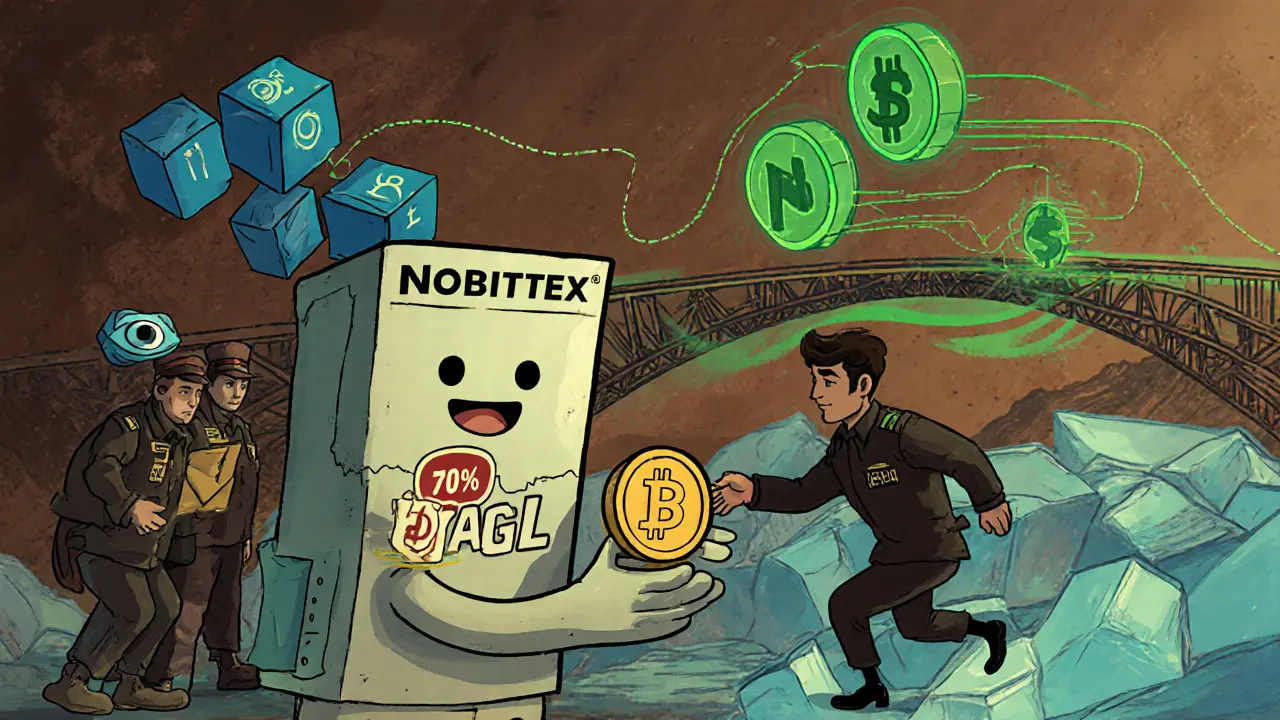Iran Crypto Adoption: Stablecoin Comparison Tool
Stablecoin Feature Comparison
Compare key attributes of USDT (Ethereum) and DAI (Polygon) to understand which is better suited for Iranian users navigating sanctions.
USDT (Ethereum)
- Transaction Fee ≈ $12-$15
- Block Time ≈ 13-15 seconds
- Regulatory Scrutiny High
- Liquidity on Iranian Exchanges Very High
DAI (Polygon)
- Transaction Fee ≈ $0.01-$0.02
- Block Time ≈ 2-3 seconds
- Regulatory Scrutiny Low
- Liquidity on Iranian Exchanges Growing
Which is Better for Iranian Users?
Based on current conditions, consider these factors:
- Cost Efficiency: DAI offers significantly lower transaction fees, ideal for frequent transfers.
- Speed: Polygon confirms transactions much faster than Ethereum, reducing delays.
- Regulatory Risk: USDT faces higher scrutiny and freezing risks due to OFAC designations.
- Liquidity: USDT has more exchange pairs, but DAI is growing rapidly.
Quick Comparison Summary
| Feature | USDT (Ethereum) | DAI (Polygon) |
|---|---|---|
| Average Transaction Fee | ≈ $12-$15 | ≈ $0.01-$0.02 |
| Block Confirmation Time | ≈ 13-15 seconds | ≈ 2-3 seconds |
| Regulatory Scrutiny | High | Low |
| Liquidity on Iranian Exchanges | Very High | Growing |
When the international community slammed sanctions on Iran in 2017, the country’s access to global finance shrank overnight. Faced with blocked SWIFT lines and frozen assets, ordinary Iranians and state‑linked actors turned to digital money as a lifeline. The result is aIran crypto adoptionecosystem that runs on a thin line between government control and underground activity. Below we unpack how sanctions have reshaped the market, who’s pulling the strings, what the rules look like, and where the trend is headed.
Sanctions as a catalyst for digital finance
Sanctions cut off Iranian banks from the world’s payment rails, forcing both citizens and state entities to search for alternatives. Cryptocurrency offered a self‑custodial, borderless option that sidestepped traditional compliance checks. Between January and July 2025, blockchain analytics firms recorded roughly USD 3.7billion in crypto flows originating from Iran, an 11% dip from the same period in 2024 but still a massive volume for a sanctioned economy.
That drop reflects intensified enforcement - not waning demand. As the Treasury Department and OFAC ramped up designations, Iranian users scrambled to adapt, showing a resilience that rivals other high‑risk jurisdictions.
Key players and infrastructure
The Iranian crypto landscape revolves around a handful of entities that blend official oversight with covert networks.
- Nobitex is the country’s largest domestic exchange, handling the bulk of Rial‑to‑crypto conversions for everyday users. Its API is monitored by the Central Bank, giving Tehran a window into transaction data.
- Islamic Revolutionary Guard Corps (IRGC) has embedded itself in crypto pipelines, using digital assets as a settlement layer for procurement networks and sanction‑evasion schemes.
- Central Bank of Iran (CBI) enforces a strict blockade on crypto‑to‑Rial conversions via public websites (Dec2024) while allowing limited, API‑based exchanges that feed user data back to the state.
- IRGC‑affiliated wallets act as collection points for funds moving through Nobitex before being layered across multiple addresses to obscure origins.
- Tether (USDT) the most used stablecoin on Iranian exchanges until a July2025 freeze targeted 42 addresses linked to the IRGC and Nobitex.
- DAI on Polygon quickly became the preferred alternative after the freeze, thanks to lower fees and faster finality compared with Ethereum.
- Office of Foreign Assets Control (OFAC) U.S. sanctions agency that designates crypto addresses alongside vessels and front companies, tightening the net around Iran’s digital finance.
Together, these actors create a dual‑track system: official channels that collect data for the state, and a shadow network that leverages VPNs, offshore exchanges, and cross‑chain swaps to stay ahead of enforcement.
Regulatory landscape - control meets necessity
Iran’s approach to crypto has swung between outright bans and pragmatic legalization.
- 2019: Mining was legalized, but miners must sell all output to the CBI at a government‑set price, effectively nationalizing the hash power.
- Dec272024: CBI blocked all public crypto‑to‑Rial conversion sites, citing money‑laundering concerns.
- Jan2025: The blockade softened; exchanges that used government‑provided APIs regained limited operating licenses.
- Aug2025: Iran passed the “Law on Taxation of Speculation and Profiteering,” imposing capital‑gains tax on crypto trades, placing digital assets alongside gold and forex for tax purposes.
These moves show Tehran’s acknowledgment that crypto is now a core part of the economy, but also its desire to keep a leash on the market. By mandating API integration, the CBI can monitor transaction volumes while still allowing citizens a legal outlet for converting fiat to crypto.

User behavior - how Iranians stay connected
Everyday Iranians have become adept at navigating a constantly shifting digital terrain.
- VPNs are the norm; community forums on Reddit and Telegram share step‑by‑step guides for masking IPs and accessing foreign platforms like Binance or KuCoin.
- After the July2025 Tether freeze, users rapidly swapped USDT for DAI via Polygon bridges, citing lower gas fees (≈$0.01 per transaction) and faster block times (2‑3seconds vs 12‑15seconds on Ethereum).
- Stablecoin arbitrage is common - traders convert Rial to USDT on Nobitex, move the tokens to Polygon, swap for DAI, and then cash out on less‑regulated exchanges in the UAE or Hong Kong.
- Mining has gone semi‑clandestine; high energy tariffs push many operators underground, using stolen electricity or tapping into Iran’s subsidized grid.
These practices illustrate a sophisticated user base that treats crypto not as a speculative hobby but as a financial survival tool.
Market size and flow dynamics
According to blockchain intelligence firms, sanctioned jurisdictions moved $15.8billion in crypto in 2024, with Iran accounting for nearly 60% of that volume. The country’s share rose sharply after the 2017 sanctions wave, making it the most active sanctioned actor by transaction value.
Key metrics for 2025 (Jan-Jul):
- Total inflow: USD3.7billion
- Dominant stablecoins: USDT (45%), DAI (30%), USDC (15%)
- Exchange concentration: Nobitex handles ~70% of Rial‑to‑crypto trades
- Mining hash rate: ~12% of global hash power, but only ~3% is officially licensed
Even with an 11% decline in the first seven months, demand remains robust because traditional banking channels are still blocked.
Enforcement actions and rapid adaptation
International watchdogs have sharpened their focus. Notable events in 2025 include:
- July22025: Tether froze assets in 42 Iranian‑linked wallets, many tied to Nobitex and IRGC addresses.
- 2024-2025: OFAC issued 13 designations of crypto wallets, the second‑highest in seven years.
- Aug2025: A coordinated crackdown targeted over 75 individuals and entities across China, HongKong, and the UAE for facilitating Iranian oil payments via crypto.
Each crackdown prompted a predictable pattern: users exit the targeted asset, migrate to a less‑monitored chain, and spread the load across multiple wallets. The July2025 shift from USDT to DAI on Polygon is a textbook example of this cat‑and‑mouse game.

Risks, challenges, and future outlook
While the ecosystem shows resilience, several headwinds could reshape it:
- Energy costs: Subsidized electricity may be rolled back, squeezing underground miners further.
- Regulatory tightening: If Tehran decides to clamp down on VPN usage or enforce stricter API compliance, domestic exchange volumes could tumble.
- International coordination: More aggressive wallet designations and cross‑border banking pressure could limit the ability to off‑ramp crypto into fiat.
- Technology shifts: Emerging layer‑2 solutions (e.g., zk‑Rollups) may offer Iranians new avenues for cheap, fast transfers, forcing sanction enforcers to adapt again.
Given the deep‑rooted need for alternative finance, crypto adoption in Iran is likely to stay high as long as sanctions linger. The government will probably continue a hybrid strategy: keep domestic exchanges under surveillance while tacitly allowing the underground market to function, because a total shutdown could spark economic unrest.
Stablecoin comparison - USDT vs DAI on Polygon
| Feature | USDT (Ethereum) | DAI (Polygon) |
|---|---|---|
| Average transaction fee | ≈$12‑$15 | ≈$0.01‑$0.02 |
| Block confirmation time | ≈13‑15seconds | ≈2‑3seconds |
| Regulatory scrutiny | High - frequently targeted by OFAC freezes | Lower - fewer direct designations |
| Liquidity on Iranian exchanges | Very high (Nobitex pairs) | Growing, but still limited |
| Cross‑chain bridge availability | Numerous (Ethereum mainnet) | Polygon‑Ethereum bridge, also Binance Smart Chain |
When sanctions freeze USDT wallets, the low‑cost, fast Polygon network becomes a lifeline for Iranians needing to preserve value without triggering immediate freezes.
Frequently Asked Questions
Why does Iran rely heavily on stablecoins?
Stablecoins give a predictable USD‑pegged value while staying on‑chain. For Iranians facing hyperinflation and Rial devaluation, moving funds into USDT or DAI preserves purchasing power and allows quick cross‑border transfers without bank intermediaries.
How does the Central Bank monitor crypto activity?
Domestic exchanges must integrate a government‑issued API that logs every trade, user ID, and wallet address. The CBI can then analyze flow patterns, flag suspicious volumes, and enforce tax or freezes as needed.
What happened during the July2025 Tether freeze?
Tether’s compliance team, acting on OFAC designations, locked 42 wallets linked to Iranian entities. The freeze immobilized over $250million worth of USDT, prompting a rapid shift to DAI on Polygon as users sought a less‑targeted stablecoin.
Is crypto mining still legal in Iran?
Yes, but only licensed operators can mine and must sell all output to the Central Bank at a state‑set price. Unlicensed mining is illegal and often runs underground due to high energy tariffs and the risk of equipment seizure.
Will sanctions eventually stop crypto use in Iran?
Unlikely. As long as traditional banking remains blocked, digital assets provide the only practical way for individuals and businesses to move value internationally. The government may tighten controls, but a complete ban could trigger economic unrest.




